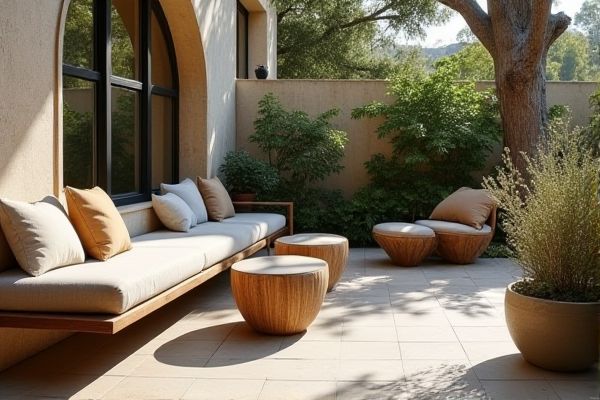
Bench seating provides a comfortable, spacious option for terrace gatherings, encouraging social interaction and relaxation, while stool seating offers a versatile, space-saving alternative ideal for smaller terraces or casual settings. Explore the advantages and considerations of both to determine which best suits your outdoor space and lifestyle needs.
Table of Comparison
| Feature | Bench Seating | Stool Seating |
|---|---|---|
| Space Efficiency | Moderate; fits multiple people in a fixed area | High; individual stools take less space, flexible arrangement |
| Comfort | High; back support often included | Low to Moderate; limited or no back support |
| Flexibility | Low; fixed seating, less rearrangement | High; easy to move and adjust |
| Capacity | Fixed; accommodates more people simultaneously | Variable; depends on number of stools |
| Durability | Typically sturdy, good for outdoor terraces | Varies; depends on material quality |
| Maintenance | Lower; fewer individual pieces to clean | Higher; multiple stools require separate upkeep |
| Aesthetic | Classic, cohesive look | Modern, casual vibe |
Introduction to Terrace Seating: Benches vs Stools
Terrace seating options like benches and stools offer distinct advantages for outdoor spaces. Benches provide ample seating space, encouraging social interaction and comfort with back support, while stools save space and allow for flexible arrangements with easy mobility. Choosing the right terrace seating depends on your space constraints and desired functionality for hosting or relaxation.
Space Efficiency: Maximizing Layout with Benches or Stools
Bench seating maximizes space efficiency on terraces by accommodating more people within a compact footprint, ideal for tight layouts and communal settings. Stools offer flexibility and are easier to rearrange, making them suitable for dynamic spaces where seating configurations frequently change. Choosing between benches and stools depends on the terrace size and usability goals, with benches optimized for fixed, high-capacity seating and stools favored for adaptable, individual seating options.
Comfort Comparison: Benches Versus Stools
Bench seating on terraces offers superior comfort due to its wider surface area, allowing users to relax without feeling constrained. Cushioned benches provide back support and accommodate multiple people, enhancing social interaction and comfort. In contrast, stool seating often lacks backrests and padding, making it less comfortable for extended use but more space-efficient for compact terraces.
Aesthetic Appeal: Design Versatility of Bench and Stool Seating
Bench seating offers a sleek, cohesive look that enhances the aesthetic appeal of your terrace with its ability to accommodate multiple people in a streamlined design. Stool seating provides exceptional design versatility, allowing you to easily rearrange or add seats to suit different occasions and styles. Both options can be tailored with various materials and finishes to complement your terrace's overall decor and maximize visual impact.
Social Interaction: Group Dynamics and Seating Style
Bench seating on terraces fosters closer social interaction by allowing groups to sit side-by-side, enhancing face-to-face conversations and collective engagement. Stool seating encourages more casual, individual experiences, often creating semi-private spaces that limit group interaction and spontaneous dialogue. Group dynamics thrive in bench arrangements where proximity supports inclusivity, collaboration, and shared experiences in outdoor social settings.
Durability and Maintenance: Benches Versus Stools
Bench seating on terraces generally offers greater durability due to its solid construction, often made from treated wood, metal, or composite materials designed to withstand outdoor elements. Maintenance for benches typically involves periodic cleaning and occasional refinishing or sealing to protect against weather damage and wear. Stools, particularly those made from lighter materials like plastic or untreated wood, may require more frequent replacement or repairs, although their simpler design can make day-to-day cleaning easier compared to benches.
Accessibility and Inclusivity: Which Seating Wins?
Bench seating on terraces offers greater accessibility and inclusivity by accommodating various body sizes, mobility aids, and groups, providing continuous support and reducing barriers for individuals with disabilities. Stools often require higher coordination and balance, which may limit use for elderly or physically challenged individuals, while benches allow easier transfer from wheelchairs. Overall, bench seating promotes a more inclusive environment by offering stable, spacious, and universally accessible seating options.
Cost Considerations: Budgeting for Benches or Stools
Bench seating generally offers a more cost-effective solution for terraces by accommodating multiple guests in a single unit, reducing the need for several individual pieces. Stools may require a higher overall investment due to their quantity and potential for higher per-unit prices, but they provide flexibility in arrangement and storage. Your choice should balance initial purchase costs with long-term space efficiency and usage frequency to align with your terrace budget.
Weather Resistance for Outdoor Terrace Seating
Bench seating for outdoor terraces often features durable materials like treated wood, metal, or synthetic composites designed to withstand rain, UV rays, and temperature fluctuations. Stool seating, commonly made from metal or plastic, offers easy mobility but may require weather-resistant coatings to prevent rust and fading in harsh conditions. Choosing weather-resistant finishes and materials such as powder-coated steel or marine-grade polymers enhances longevity and maintains appearance in varied outdoor climates.
Choosing the Right Seating: Benches or Stools for Your Terrace
Benches provide spacious, comfortable seating ideal for social gatherings, offering a cohesive look and maximizing space along terrace edges. Stools offer flexibility with lightweight, movable designs perfect for smaller terraces or casual setups, allowing you to easily reconfigure seating arrangements. Your choice depends on terrace size, desired comfort level, and whether you prioritize fixed seating or versatile options.
 homyna.com
homyna.com